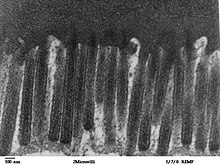Microvillus
Microvillus (plural microvilli) is a very tiny hair-like membrane in the body. The microvillus greatly increase the amount of surface area for a cell.[1] In humans, the microvilli can give a cell 600 times more surface area. They are good for absorbing things and for secreting things. They are found in many places in a human body including the ear, the tongue, the nose and the intestines.

On a tongue, the microvilli are the tiny hairs on the taste buds that send signals to the brain. These signals are interpreted by the brain, and tells the brain what things taste like. Over time, as a person tastes more and more things, the brain stores the information the microvilli send in a databank of information. This databank is used to compare new tastes to old tastes, and help to classify them by comparing and contrasting their qualities.
In the intestines, the microvilli are able to absorb (take) nutrients from the digested food for the body to use.
References
change- ↑ Lange, K. (2011). "Fundamental role of microvilli in the main functio... [J Cell Physiol. 2011] - PubMed result". Ncbi.NLM.nih.gov. 226 (4): 896–927. doi:10.1002/jcp.22302. PMID 20607764. S2CID 206049291. Retrieved 9 March 2011.